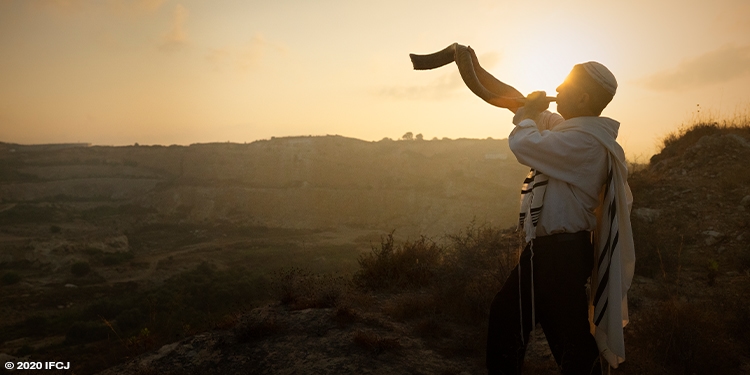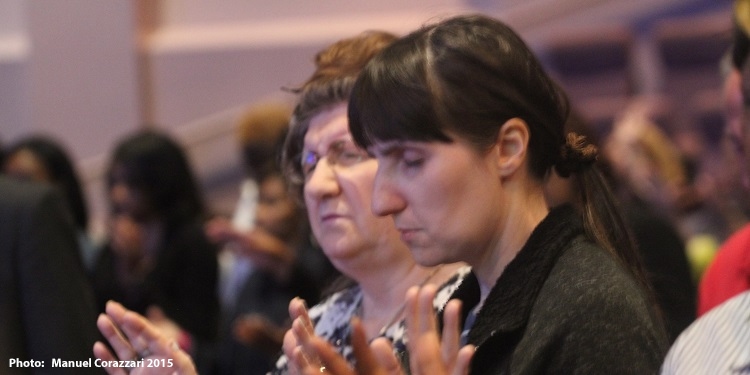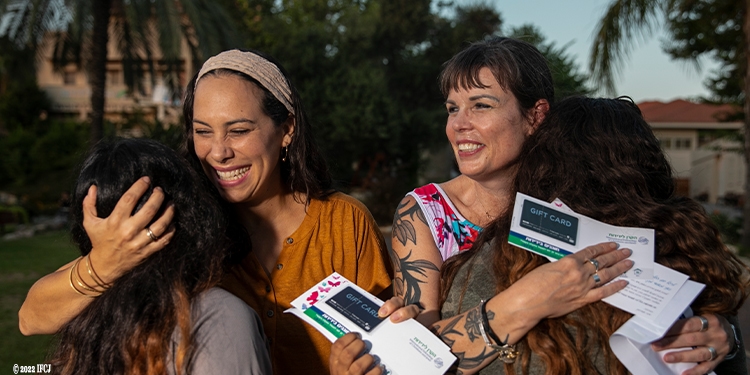What Are the High Holy Days?
The Fellowship | August 16, 2023

The High Holy Days, also known as the Ten Days of Repentance, or the Days of Awe, are the most widely observed Jewish holidays, beginning with Rosh Hashanah, the Jewish New Year, and ending ten days later with Yom Kippur, the Day of Atonement.
While these are the two main holy days, the High Holiday season also includes Sukkot, the Feast of the Tabernacles, Shemini Atzeret, the “Eighth Day of Assembly,” and Simchat Torah, which literally means “Rejoicing in the Torah.”
Here is a quick description and dates for the High Holy Days observances for 2023:
Rosh Hashanah
- Begins at sundown Sept. 15 and ends at sundown Sept. 17
- Rosh Hashanah, the Jewish New Year, literally means “the head of the year”
- Main focus of this observance is intense moral and spiritual introspection as Jews prepare themselves for God’s judgment of the preceding year
- God “writes” His judgment on the world on Rosh Hashanah and it is “sealed” ten days later on Yom Kippur
- The ten days between Rosh Hashanah and Yom Kippur are known as the Ten Days of Repentance, or the Days of Awe
- To learn more about Rosh Hashanah, check out our resource page, What Is Rosh Hashanah?
Yom Kippur
- Begins at sundown Sept. 24 and ends Sept. 25
- Yom Kippur, the Day of Atonement, is the holiest day of the year in Judaism
- Main focus is atonement and repentance
- The day is observed with a 24-hour fast, during which Jews are in synagogue beseeching God for forgiveness
- It is the final opportunity to repent before God’s judgment is “sealed”
- To learn more about Yom Kippur, check out our resource page, What Is Yom Kippur?
Sukkot
- Begins at sundown on Sept. 29 and ends at sundown Oct. 6
- Sukkot, also known as the Festival of Tabernacles or the Festival of Booths, is a joyful celebration
- Main focus is a joyous celebration of the harvest and a time to remember God’s provision for His people while they wandered in the desert after the Exodus from Egypt
- Main observance is building a sukkah, temporary dwellings that resemble what their ancestors lived in during their time in the desert.
- Sukkot is one of three pilgrimage holy days mandated in the Bible, along with Passover and Shavuot (Pentecost), during which Jews were required to travel to the Holy Temple in Jerusalem
- Many believe Sukkot was the inspiration for the American Thanksgiving
- To learn more about Sukkot, check out our resource page, What Is the Festival of Tabernacles-Sukkot?
Shemini Atzeret
- Begins at sundown on Oct. 6 and ends at sundown Oct. 8
- Shemini Atzeret, or the “Eighth Day of Assembly,” immediately follows Sukkot
- The day marks the end of this intense journey of reflection and celebration and acts as a transition back to the routine of life
- As it is connected to Sukkot, it is celebrated in the sukkah and is marked by the prayer for rain, officially starting the rainy season in Israel
- To find out more about Shemini Atzeret, check our our resource page, What Is Simchat Torah?
Simchat Torah
- Begins at sundown, Oct. 7, and ends at sundown on Oct. 8
- Simchat Torah, which literally means “Rejoicing in the Torah,” is a joy-filled celebration, marking the completion of the annual reading of the Torah, from Genesis to Deuteronomy
- The observance is marked in the synagogue with dancing and singing as the Torah scrolls are carried around the sanctuary seven times
- The holiday underscores the centrality of the Torah to Jewish life as a gift from God and as a source of Jewish identity
- To find out more about Simchat Torah, check our our resource page, What Is Simchat Torah?
How Do Jews Prepare for the High Holy Days?
The month preceding the High Holy Days, the month of Elul in Hebrew, is a time of preparation for these holy days, involving intense reflection and soul-searching, known in Hebrew as cheshbon hanefesh —literally “an accounting of the soul.”
This month long process culminates on Rosh Hashanah when, Jewish tradition teaches, all humanity is called to judgment before a holy and merciful God. The customs and traditions associated with Elul are intended to cultivate the proper mindset.
One of the best-known traditions is the blowing of the shofar, the biblically mandated trumpet made from a ram’s horn, after morning services at the synagogue. Many families also blow the shofar in their own homes. The sounding of the shofar is intended as a “wake-up call,” to rouse the people form their spiritual stupor and jolt them into repentance. At this time, it is also customary to recite from Psalm 27, which speaks of assurance of God’s protection, along with a plea that God will not forsake His children.
Jews around the world also prepare their hearts using three biblical principles, known as the Three Pillars: repentance, prayer, and charity.
The First Pillar
The first of these pillars is repentance, which is, simply, “getting right with God.”
There’s so much happening in our modern world that constantly distracts us from God and His love; as a result, we often lose our way. Repentance is about taking a moment to examine our hearts and see the places in our lives where God needs to be invited back in.
Interestingly, there is no Hebrew equivalent for the word “sin.” The closest to it is the word “chet,” but what that word literally means is “a miss.” When someone aims an arrow at a target, but fails to hit it, it is called a chet. This word implies that that the shooter missed the mark.
Another Hebrew word used to denote wrongdoing is “aveira,” which literally means “a cross over.” This word indicates that a line was crossed. It suggests that there is a proper path and that the perpetrator, knowingly or mistakenly, went off track.
These nuances are profound. They emphasize the idea that while we may miss the mark or veer off the path of righteousness, we can correct our error and return. With time and practice, we can get closer to hitting our target and staying on track. Our job is to “get right with God,” to align our intentions and aspirations to His will. Getting things right will come with time, so long as we keep trying and improving.
With this understanding in mind, we can also appreciate the Hebrew word for repentance, “teshuvah.” The root of the word teshuvah is shuv, which in Hebrew means “return.”
In the Book of Joel we are directed, “Return (Shuvu) to the LORD your God, for he is gracious and compassionate, slow to anger and abounding in love” (2:13). To repent is to return to God and to return to our true selves. When we have missed the mark or crossed the line, the act of repentance is a return to the right path and the right direction.
Discover why the High Holy Days are meaningful to all Bible-believers and while we may observe these days differently, they are sacred to us all.
The Second Pillar
The second pillar is prayer, communing with God.
Jewish prayer is made up of three components: Praise, thankfulness, and requests. Yet, these elements are not intended to change God’s mind regarding what we want in our lives. Rather, they are meant to change our character and our perspective on life. When we praise God, we are humbled before Him. When we thank God, we are grateful for His many blessings. When we ask God for the things that we need, we are forced to take a good look at the things that are truly important to us. When we ask God for what we want, we appreciate that He is the ultimate provider. When we talk to God about our lives, we become closer to Him.

Prayer is the foundation of our relationship with God. Through prayer we develop our love for God and experience His love for us. As in any relationship, we need to make our relationship with God a priority, dedicating time and putting in the effort to nurture our connection. The entire purpose of prayer is to develop and deepen our relationship with our Creator.
Remember, God does not “need” our prayers. He already knows what we want and what we need. God does not need our compliments or our thank yous. What God wants is our hearts. He says, “My son, give me your heart and let your eyes delight in my ways” (Proverbs 23:26). This is the time to renew our relationship with God, to give Him our hearts in prayer, and to step into the New Year together.
Learn insightful lessons by studying the prayers of godly men and women such as Isaac, Jacob, Miriam, Hannah, King Solomon and more in this complimentary download, Work of the Heart.
The Third Pillar
The third pillar of celebrating three virtues is charity, giving back to God.
In Hebrew, the word for charity is tzedakah. It is comprised of two Hebrew words: tzedek (justice), and kah, a name of God. Together, these words describe charity as “the justice of God,” and as “righteous giving.”
Giving to the needy is not only an act of mercy, it is an act of righteousness, something that we must do as servants of God – not only because we want to, but also because it is the right thing to do. When we give tzedakah, we testify that everything in the world belongs to God. If we have been blessed, it is so we might bless others. God says, “The silver is mine and the gold is mine” (Haggai 2:8), the Bible tells us. Nothing is really ours in the first place.

Moreover, when we give to others from what we have, we demonstrate great faith. We trust that God will sustain us according to His promise that “Those who give to the poor will lack nothing” (Proverbs 28:27).
In addition, God declared that when we give tzedakah, not only will He pay us back, He will increase us. “Bring the whole tithe into the storehouse, that there may be food in my house,” God says. He promises, “Test me in this…and see if I will not throw open the floodgates of heaven and pour out so much blessing that there will not be room enough to store it” (Malachi 3:10).
When we give tzedakah, we quite literally “put our money where our mouth is.” We take the faith that is in our heart, and the faith that we speak with our mouths, and turn it into action.
Finally, we focus on charitable giving during the High Holiday season because the poor and needy are God’s children. As we turn to our Father in Heaven for all of our needs, we cannot turn away from our brothers and sisters on earth who desperately need our help.
When you get right with God, it creates a thankful heart for all He’s done. And a thankful heart is a generous heart: you want to spread God’s love to others.
More High Holy Days Resources
- Tzedakah, which means righteous giving, goes far beyond the traditional concept of charity and charitable giving. Download our resource to learn more about this fundamental value in Judaism in this excerpted chapter from Yael’s book, Generation to Generation.
- QUIZ: Test your knowledge with our High Holy Days Quiz, and see what you know about this most sacred time on the Jewish calendar.
